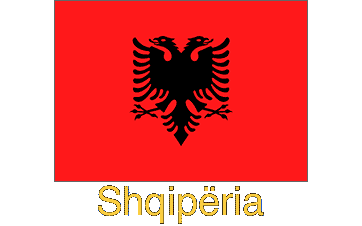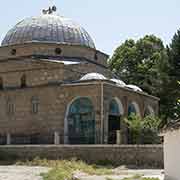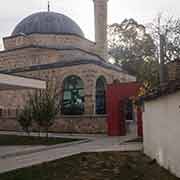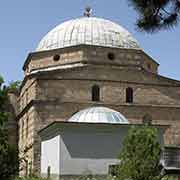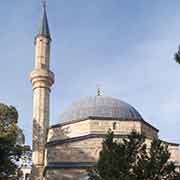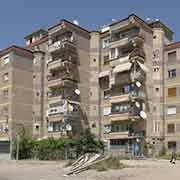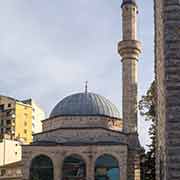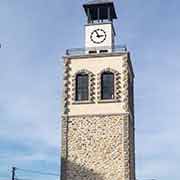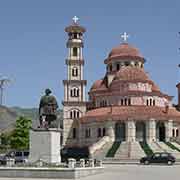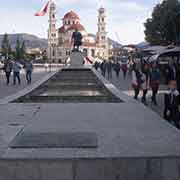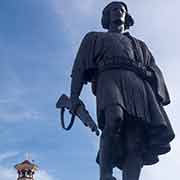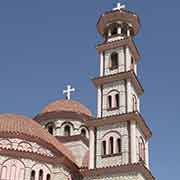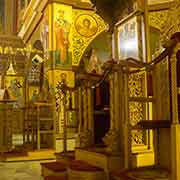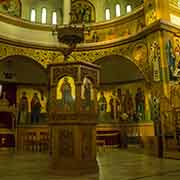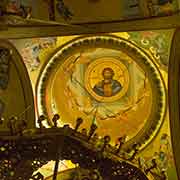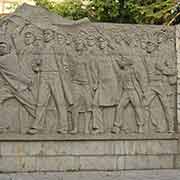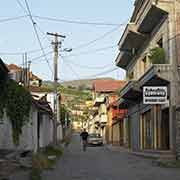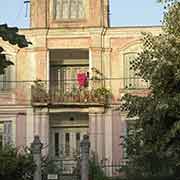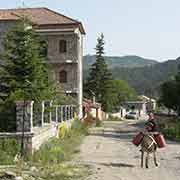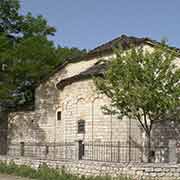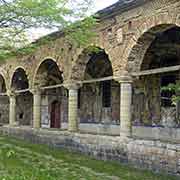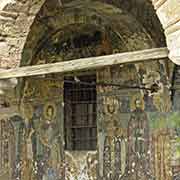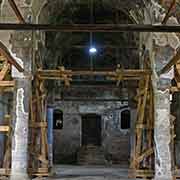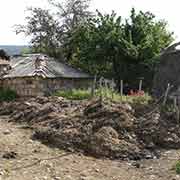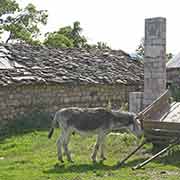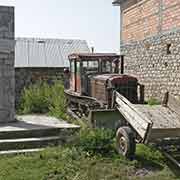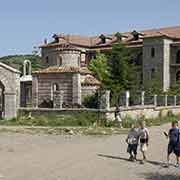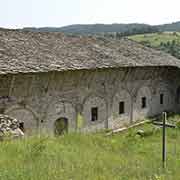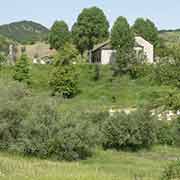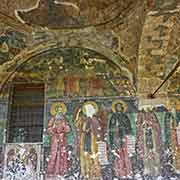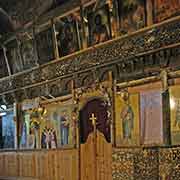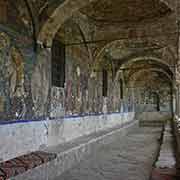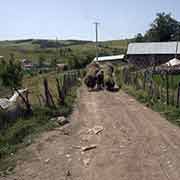Photos from Albania
Eastern Albania’s Korça District
Korça (or Korçë in a sentence with a preposition) is the main city of south-eastern Albania. It is situated on a plateau, surrounded by the Morava Mountains at about 850 metres above sea level. The site has been continually inhabited for 6,000 years, with strong Greek cultural influence in the Iron Age. It was influential in the spread of Byzantine Christianity, with a church established in 898.
you may then send it as a postcard if you wish.
It was a feudal estate in the 13th Century. In 1484 Koja Mirahor İlyas Bey, the local lord and a Muslim convert, who had taken part in the 1453 Ottoman siege of Constantinople, returned. He developed Korça under the command of Sultan Mehmet II and in 1494 built the single-domed Xhamia e Mirahorit (Mirahori Mosque) that still bears his name. It is one of the most architecturally significant mosques in Albania. Korça was rivalled by nearby Voskopoja, which in the mid-18th Century counted about 30,000 inhabitants. Some claims are over 60,000, including immediate surroundings. That would have made it the second-largest city of European Turkey, after Constantinople, now İstanbul. But the Ottomans mounted military expeditions against Voskopoja during the late 18th Century; the town declined rapidly, and Korça became the regional centre. Today it has a population of over 100,000.
From the 17th Century onwards, Korça was a centre of commerce and trade. It was an important stopping point on the caravan routes in those days. In the 19th Century, it became a centre of the growth of Albanian national consciousness (“Rilindja”). The first school to use the Albanian language opened here in 1887; its building is now the Museum of Education. Upon the declaration of Albanian independence in 1912, Korça was seized and occupied by Greek irredentist forces who called it Koritsa and claimed it and its surroundings as Greek territory. In 1920, after great turmoil during the Balkan Wars, the First World War and a four-year French occupation, Korça was finally awarded to Albania by the International Boundary Commission. Enver Hoxha, the Albanian communist leader, attended and later taught at the Lycée (public secondary school) that the French had founded in 1916. The Italians used the city as a military base for operations against Greece during World War II; It was occupied in 1940-41 by the Greeks, then by the Germans, and finally, in 1944, it was restored to Albania. Korça suffered greatly from the brutal redevelopment by the Hoxha regime. The old bazaar area was all but demolished, the Mirador mosque used as a warehouse, and the Shën Gjergj (St. George) Orthodox Church of Albania destroyed. But after the end of the Communist regime, much has been restored; the impressive Resurrection of Christ Cathedral has been built, replacing the demolished St. George.
Voskopoja (or Voskopojë in a sentence with a preposition) is now a small village, 21 kilometres west of Korça in south-eastern Albania. In the 18th Century, known as Moscopole, it was a rival of Korça, a major Balkan city and a cultural and commercial centre of the Aromanian people, also known as Vlachs. At its peak, in the 1760s, it had a population of over 60,000. It was the second most important city of the Balkans regarding population and prosperity. The city was surpassed only by Constantinople; it had the first printing press in the Balkans, banks, a university and 70 churches. It acted as a business entrepôt between Venice and Constantinople. The language spoken here was Aromanian, also known as Macedo-Romanian or Vlach, an Eastern Romance language, centred mainly in North Macedonia. There were also Greek merchants; Greek was used in commercial contracts, and the Aromanian language was written in the Greek alphabet. The city’s wealth aroused the jealousy of the Turkish beys in the surrounding areas, and between 1769 and 1789, they mounted various military expeditions against the city. Many Christians were murdered or expelled, and their houses burnt down. The town declined while Korça grew as the regional capital. It suffered severe damage from vicious inter-communal fighting during the Balkan wars in 1911-12, in conflicts over control of Korça during and after the First World War and most of all in battles between Axis troops and partisans during 1943-44. As a result, it is now just a small village and centre of pastoral agriculture, inhabited mainly by Vlach shepherds.
There are still reminders of the old days, with well-paved streets running between farm buildings. Only five Orthodox churches survive in a poorly maintained state. During the prohibition of religion in communist Albania in 1948, they were declared “Cultural Monuments”. In 2002 they were put on the World Monuments Fund’s Watch List of 100 Most Endangered Sites. Most churches resemble barns: in the Ottoman days, churches were tolerated here as long as they didn’t look too much like churches from the outside. The best preserved of these is the Church of Shën Kollë (St. Nicholas’ Church, Kisha e Shën Kollit), built-in 1721, in the centre of the village. It is the only one that can be visited if the caretaker with the key can be found. It has icons and frescoes in great need of restoration. St. Michael’s Church on the northwest side of town was built in 1722. It is locked and empty, but an idea of former glory can be seen through a hole in the wall. In 1996 the church was vandalised, and 23 paintings of Saints were severely damaged; it seems restoration work is in progress. St. Athanasius Church (Kisha e Shën Thanasit) was built in 1721 and now serves as a cemetery church in the old Moscopole. It also has frescoes but has also suffered from the theft of its church icons.


